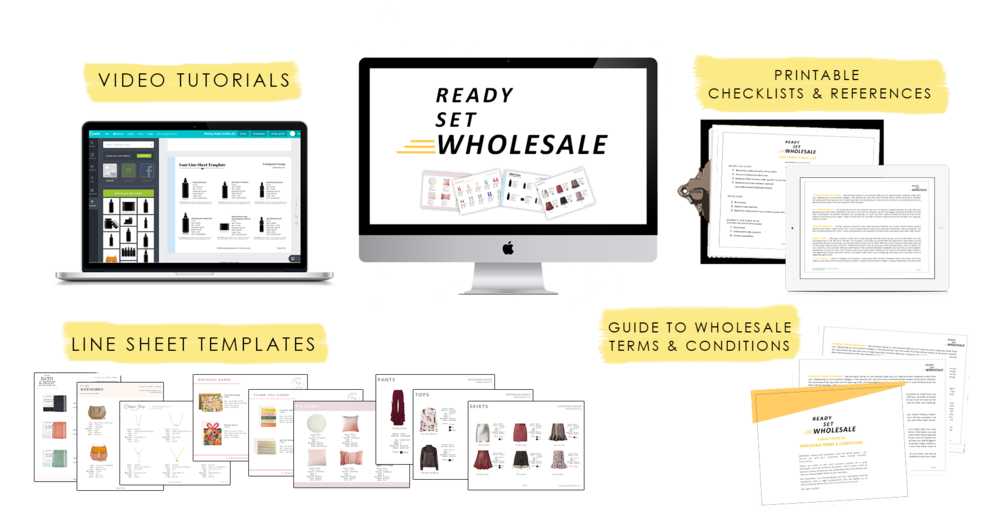
We are really fanatical about the thing we call the five Rules. These are not just rules, but they are like the superfoods for the business. The fourth rule is: begin with good enough and then make it even better. It really sounds simple, but it’s possibly the rule that individuals struggle the most with. Most of the time, individuals run around making all just perfect before they begin; they are always some months from having all the ducks in the row.
They always think they require more of something before beginning. Also, sometimes, individuals we work with do start with something good enough (but lacking.) And we are really excited! We applaud! It’s the best method to learn and the quickest path to grow the wholesale! But then, numerous weeks into the outreach to shops, they get disheartened because they are not getting the outcome they desire. They try to be unrelenting. But occasionally, a creator decides that this course is not working and renounces.
The two options aren’t perseverance or giving up. If there’s anything that we have learned in the industry, it’s this: in the adversity face, the options aren’t a) be obstinately persistent or b) give up. There’s a 3rd option as well, which is to be persistent to grow the wholesale business and connect with different shops, but totally willing to assess what’s really working, what’s not, and alter anything that’s not helping.
Different Methods Of Making The Line Sheet Dramatically Better In A Weekend:
The following are a few methods that you can make use of to make it better after Creating A Line Sheet For Wholesale.
Tell The Story To The Heart:
We think that when we submit the work for contemplation, the store owner or buyer is doing an entirely rational, thought-through assessment of whether or not your product is good enough to be in the shop. We think that when we get the refusal, they determined it was not good enough. The fact is that shop owners (and purchasers) do not always decide in the manner we think they really do. Frequently, a retailer will purchase if the heart really lights up about a thing (and if the head does not refuse, more on that piece in the next part.)
If the shop owners cared just about the cents and dollars and figures and facts, they might be in a diverse line of work than curating an artistic boutique in the unsupportive economy. The shop owners care about being moved, being inspired, being excited, both because that is why they own a shop in the first place and because they acquaint that their capability of sharing such emotions with their consumers is their manner to make the sale. The first job is to tell the story to the shop owner’s heart.
The story is all about you, your process, your product, and the individuals who will make use of or wear the product. It is a story about an emotion or a journey. Perhaps it is a story about your wild freedom and how the correct accessories can really make a lady feel that wind-in-the-hair sense. Perhaps it is about celebratory meals and family, and how the ideal linen tea towel is the seed for such connection feelings. A few purchasers will get it immediately, but, as you grow and get into the wider audience, these are a few of the questions you desire to address through the line sheet:
- I am intrigued, but how are individuals supposed to utilize such products?
- What’s exciting and new and meaningful about your product? How’s it diverse from everything else that can be seen out there?
- How am I gonna show such products in a manner that will make people desire to purchase them? How will my consumers acquaint how such products really fit into their lives?”
A few parts you can utilize for weaving a story that can quell all of such questions and lights the spark in the store owner’s heart:
- Gorgeous photographs of individuals utilizing the products in particular ways or with a particular point of view.
- The spacing, font, and the other visual language that you make use of throughout your doc.
- Descriptions and photos of the sourcing, process, and background
- Particular descriptions of how your products are utilized
- Photographs of how the retailer may show your products, particularly if that comprises packaging or show that you’ll comprise with the order.
Examples of what you should really evade:
- If your line sheet’s visual language isn’t consistent with the brand’s personality. For example, if the line sheet is minimal and severe, but the jewelry is nature-inspired and soft, that story will definitely not land.
- If the line sheet is visually not pleasant or is cluttered, you’re not telling the story effectively.
- If there’re no images of the art in the context of the living situation, it is difficult to tell what style it can really fit into because it can certainly go anywhere or nowhere at all.
- If you sell your accessories, but they’re no images of ladies wearing them, it is really difficult to picture who will purchase them in the shop.
Make Certain They Aren’t Confused:
Do not forget what you are attempting to do right here. Once you have sparked the shop owner’s heart, the main job of your line sheet is to really show what you’re really selling, for how much cash, and under what conditions and terms.
Put The Beer Goggles On:
At times I tell a creator that a part of a line sheet is perplexing. Yes, they really tell me, but in fact, I explained it on page number 7, particularly if you glance again on page number 49. Remember in the health class of the tenth grade when they asked you to put on those fuzzy-lensed beer goggles actually to show what it’s like to drive while drunk?
You have to put on the board, rushed, multitasking beer goggles for making certain that the line sheet is crystal clear adequate for communicating efficiently. Assume that a shop owner opened the line sheet while they are on the phone with the mechanic, realizing their PC has a virus, holding their baby, and eating a sandwich. Now tell me if the line sheet is clear adequate.
- Is it clear how much every item really charges wholesale, how much you can charge for that retail, and what the shipping, payment, and turnaround terms really are?
- Is it obvious what the back, front, outside, inside, and sides of every product look like?
- Is it obvious which product number/name goes with which?
- Is it completely clear what every product is made out of and how the production procedure is different or the same across a line?
- Am I left trying to understand how I’d show the line?
- Do I really have to wonder how products will be packaged and/or arrive at the shop?
- Is it abundantly clear how I place the order?
Diverse strokes for diverse folks: when and how to divide up the different collections. Once you’ve all clear in the line sheet, there’s one other obstruction that individuals run into, the line that isn’t completely cohesive in terms of style, price, or both. It really goes back to the concept that the puzzled mind does not purchase. If I am glancing at the line, and sixty percent of the pieces read modern and minimal and edgy, and forty percent of the pieces read playful and sweet, I am puzzled. If the line has eighty percent things that cost 100+ dollars and twenty percent of the things costing less than thirty dollars, I am confused.
Get Rid Of As Many Obstructions As Possible:
So, now you have told the story to a purchaser’s heart that really feels exciting and inspiring. And you have let their head comprehend everything unmistakably. Now you have to make certain that you have not put a big old obstruction in the path for placing the order with you. We have all had the understanding that we’re in a shop, we get something we desire to purchase, but there’s such an obstruction to purchasing it (a snooty saleswoman, a long line, a long wait for the cashier, or limited payment options) that we simply tuck the product on a random shelf and hightail that out of the shop. You do not desire to do that to the purchasers.
Here’re a few potential obstructions to make certain you really clear away: the complicated wholesale applications or order forms that you need to fill out before viewing your catalog or line sheet. A few businesses require a specific order form or a wholesale application because they have a lot of orders that they’d be buried without them. The majority of makers, though, simply utilize such things because they feel like they’re really supposed to or because it really seems professional. Professional denotes making buying efficient and easy, so if you can really dump the order form or the application, just do it. A few obstructions to purchase you may have (and can contemplate removing):
- Making your line sheet so long that it can take forever to reach the end.
- The limited disbursement methods.
- Making numerous clicks to get to the line sheet before you have described (or shown, utilizing the embedded pictures) what your line is really about.
- Making your line sheet file so huge that your email gets removed because it would not load.
Be ruthless about the line sheet’s editing parts or parts of the procedure that are not earning the keep. If it is not intensely supportive of your clarity or the story, then simply get rid of it.
Be Really Savvy With The Resources That It Really Feels Like Cheating:
At times it can feel very overwhelming to contemplate improving the line sheet because you begin picturing thousands of dollars going to graphic designers or photo-shoots. Or, creators at times say, well, I can make all of such changes myself, but I just really do not have time to give it. You can improve the line sheet dramatically with two to ten hours of work and the resources you have already got. You can improve the line sheet dramatically this weekend.
Question The Resources You Have:
You’ve more resources than you really think you do. Once you have taken the inventory of what you have to change in the line sheet (utilizing the recommendations above and the worksheet below), begin taking the resources’ inventory you already have for supporting such changes.
What Can You Do Or Utilize That’d Feel Like Cheating?
- A photographer you acquaint who always admired the necklaces, and would want to do a shoot in exchange for some pieces.
- Your own an amazing, with a fifteen dollars tripod, and the morning light in the dining space
- Your best friend, daughter, neighbor, or aunt who always has the ideal style and would make a remarkable model for the line
- Your graphic designer friend that can just come over, take some time reworking everything and leave home with the apple pie you made in thanks.
- Canva or similar, for rally overhauling the design without having to disburse Adobe a cent.
- The house in your neighborhood with a splendid living space, to make use of as the backdrop for the art pieces (shot with the phone by you, and a home-based lightbox.)
- A former collaborator who has perfect design sense and would be happy to invest some time in critiquing the visual language you make use of.
The point is, you can really make the line sheet better dramatically, at the weekend, without really overextending yourself in terms of the resource. Do what you really can, with what you really own, and that’ll begin getting you a better outcome.





